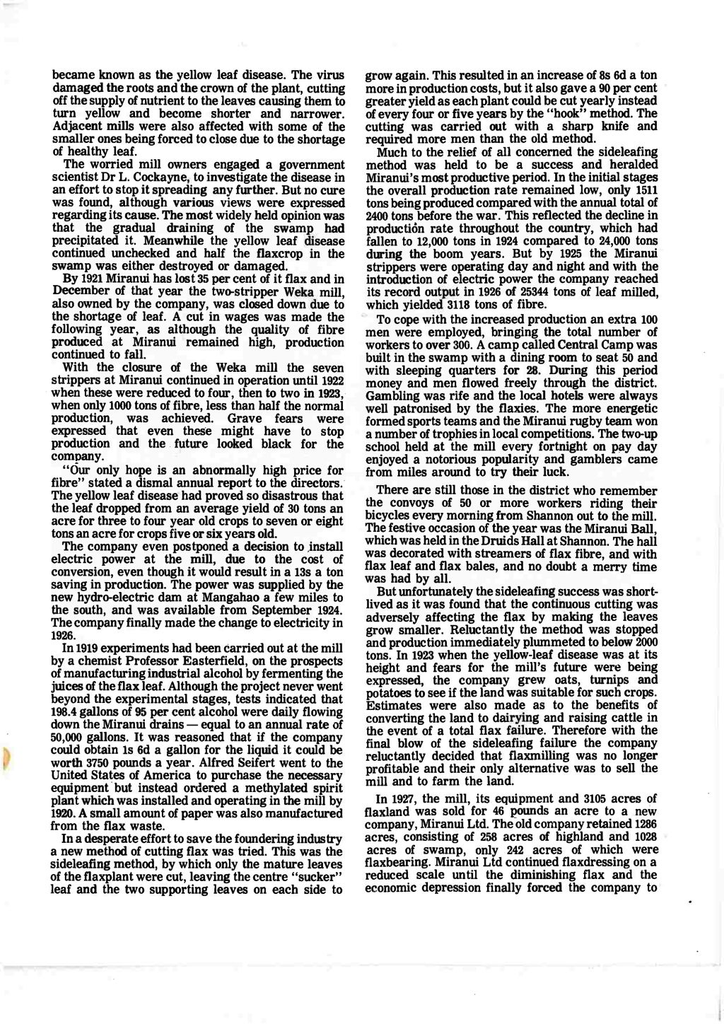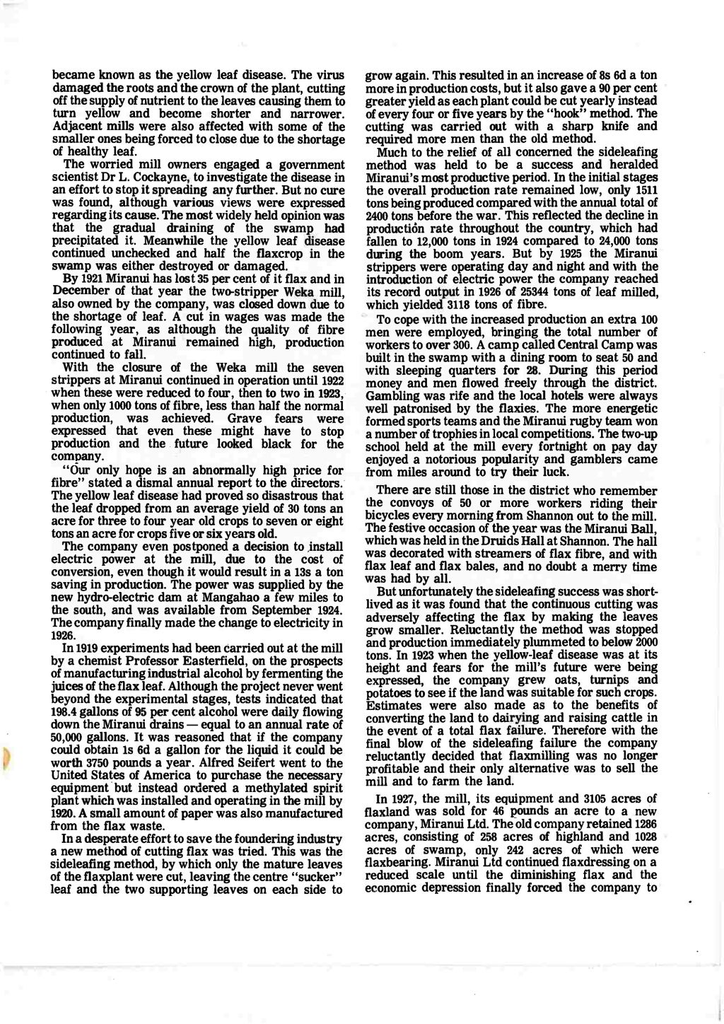Miranui - The story of New Zealand's largest flax mill - page 5
- Description
became known as the yellow leaf disease. The virus damaged the roots and the crown of the plant, cutting off the supply of nutrient to the leaves causing them to turn yellow and become shorter and narrower. Adjacent mills were also affected with some of the smaller ones being forced to close due to the shortage of healthy leaf.
The worried mill owners engaged a government scientist Dr L. Cockayne, to investigate the disease in an effort to stop it spreading any further. But no cure was found, although various views were expressed regarding its cause. The most widely held opinion was that the gradual draining of the swamp had precipitated it. Meanwhile the yellow leaf disease continued unchecked and half the flaxcrop in the swamp was either destroyed or damaged.
By 1921 Miranui has lost 35 per cent of it flax and in December of that year the two-stripper Weka mill, also owned by the company, was closed down due to the shortage of leaf. A cut in wages was made the following year, as although the quality of fibre produced at Miranui remained high, production continued to fall.
With the closure of the Weka mill the seven strippers at Miranui continued in operation until 1922 when these were reduced to four, then to two in 1923, when only 1000 tons of fibre, less than half the normal production, was achieved. Grave fears were expressed that even these might have to stop production and the future looked black for the company.
"Our only hope is an abnormally high price for fibre" stated a dismal annual report to the directors. The yellow leaf disease had proved so disastrous that the leaf dropped from an average yield of 30 tons an acre for three to four year old crops to seven or eight tons an acre for crops five or six years old.
The company even postponed a decision to install electric power at the mill, due to the cost of conversion, even though it would result in a 13s a ton saving in production. The power was supplied by the new hydro-electric dam at Mangahao a few miles to the south, and was available from September 1924. The company finally made the change to electricity in 1926.
In 1919 experiments had been carried out at the mill by a chemist Professor Easterfield, on the prospects of manufacturing industrial alcohol by fermenting the juices of the flax leaf. Although the project never went beyond the experimental stages, tests indicated that 198.4 gallons of 95 per cent alcohol were daily flowing down the Miranui drains - equal to an annual rate of 50,000 gallons. It was reasoned that if the company could obtain 1s 6d a gallon for the liquid it could be worth 3750 pounds a year. Alfred Seifert went to the United States of America to purchase the necessary equipment but instead ordered a methylated spirit plant which was installed and operating in the mill by 1920. A small amount of paper was also manufactured from the flax waste.
In a desperate effort to save the foundering industry a new method of cutting flax was tried. This was the sideleafing method, by which only the mature leaves of the flaxplant were cut, leaving the centre "sucker" leaf and the two supporting leaves on each side to
grow again. This resulted in an increase of 8s 6d a ton more in production costs, but it also gave a 90 per cent greater yield as each plant could be cut yearly instead of every four or five years by the "hook" method. The cutting was carried out with a sharp knife and required more men than the old method.
Much to the relief of all concerned the sideleafing method was held to be a success and heralded Miranui's most productive period. In the initial stages the overall production rate remained low, only 1511 tons being produced compared with the annual total of 2400 tons before the war. This reflected the decline in production rate throughout the country, which had fallen to 12,000 tons in 1924 compared to 24,000 tons during the boom years. But by 1925 the Miranui strippers were operating day and night and with the introduction of electric power the company reached its record output in 1926 of 25344 tons of leaf milled, which yielded 3118 tons of fibre.
To cope with the increased production an extra 100 men were employed, bringing the total number of workers to over 300. A camp called Central Camp was built in the swamp with a dining room to seat 50 and with sleeping quarters for 28. During this period money and men flowed freely through the district. Gambling was rife and the local hotels were always well patronised by the flaxies. The more energetic formed sports teams and the Miranui rugby team won a number of trophies in local competitions. The two-up school held at the mill every fortnight on pay day enjoyed a notorious popularity and gamblers came from miles around to try their luck.
There are still those in the district who remember the convoys of 50 or more workers riding their bicycles every morning from Shannon out to the mill. The festive occasion of the year was the Miranui Ball, which was held in the Druids Hall at Shannon. The hall was decorated with streamers of flax fibre, and with flax leaf and flax bales, and no doubt a merry time was had by all.
But unfortunately the sideleafing success was shortlived as it was found that the continuous cutting was adversely affecting the flax by making the leaves grow smaller. Reluctantly the method was stopped and production immediately plummeted to below 2000 tons. In 1923 when the yellow-leaf disease was at its height and fears for the mill's future were being expressed, the company grew oats, turnips and potatoes to see if the land was suitable for such crops. Estimates were also made as to the benefits of converting the land to dairying and raising cattle in the event of a total flax failure. Therefore with the final blow of the sideleafing failure the company reluctantly decided that flaxmilling was no longer profitable and their only alternative was to sell the mill and to farm the land.
In 1927, the mill, its equipment and 3105 acres of flaxland was sold for 46 pounds an acre to a new company, Miranui Ltd. The old company retained 1286 acres, consisting of 258 acres of highland and 1028 acres of swamp, only 242 acres of which were flaxbearing. Miranui Ltd continued flaxdressing on a reduced scale until the diminishing flax and the economic depression finally forced the company to
Identification
- Date
- 1977
Taxonomy
- Community Tags


